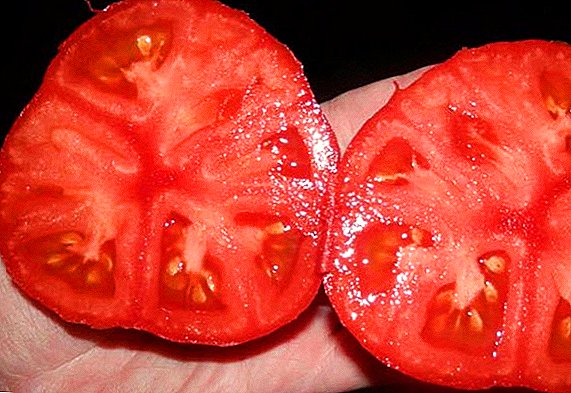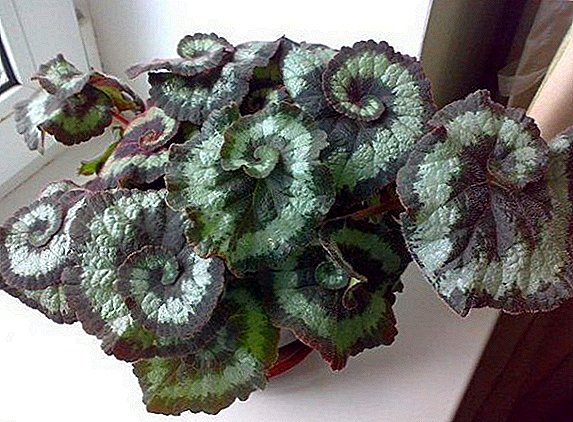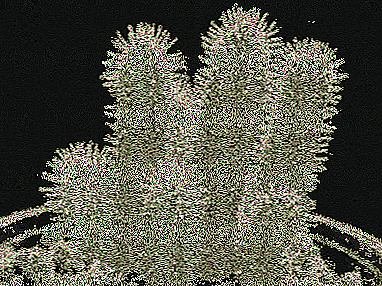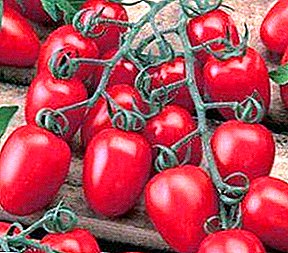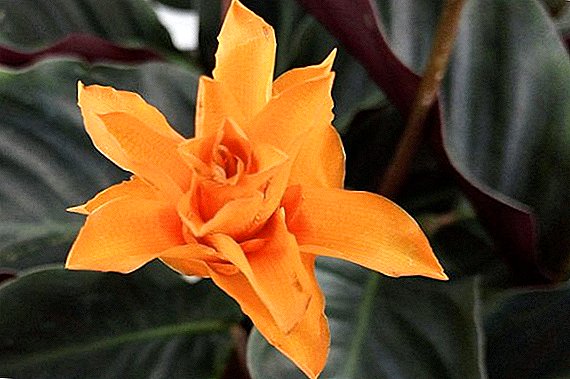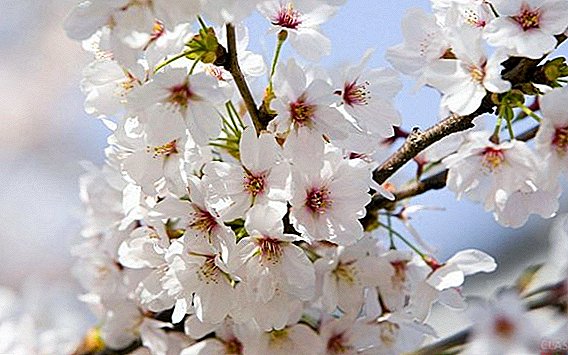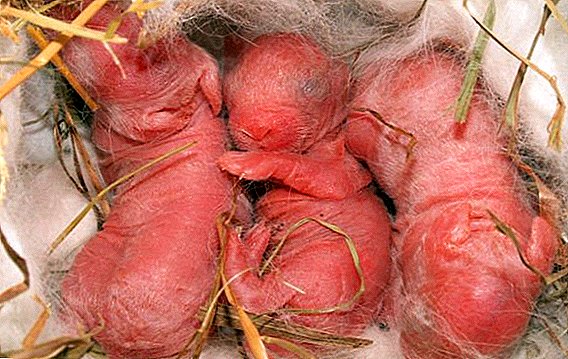 Newborn rabbits are small, fragile and defenseless creatures that need care and care.
Newborn rabbits are small, fragile and defenseless creatures that need care and care.
On how the young grows and develops, will depend on further indicators of the productivity of livestock and the appropriateness of its breeding.
How to care for rabbits and what to feed them, let's see.
Preparation for okrol
By the appearance of rabbits should be well prepared. As a rule, the pregnancy of the female lasts about one month. Previously, a week before the alleged okrol, the rabbit begins to prepare for it: tears out the fur and down, demolishes them in one of the corners of the cage to create a nest.  From this point on, you should watch the rabbit very carefully.
From this point on, you should watch the rabbit very carefully.
The breeder himself needs to arrange a place for newborns:
- set the mother of rabbit, quite spacious, but closed on all sides;
- lay litter at the bottom of the tank, which can be hay, straw, soft sawdust.
A few days before circling, the female is recommended to trim the claws so that she cannot damage the babies. After the baby rabbits are born, they should be checked with great care so as not to cause aggression in the female, otherwise she may refuse newborns.
What do newborn rabbits look like?
Cubs are born approximately 28-31 days after the fertilization of the female. The process of birth lasts differently: from 10 minutes to 1 hour. In most cases, a healthy female with lambing does not require outside help, however, she should ensure absolute peace and quiet.
Important! During the hunt, the female needs plenty of fluid. If it is "deprived" of water, it is able to scatter babies or even cripple them.
Newborn rabbits look very cute and extremely helpless. They are completely devoid of hair, they also lack vision and hearing. In the first days of life, babies resemble small pink lumps with tiny and tender legs. 
Stages of development
Despite the fact that the newborn baby rabbits look very helpless in the first days of their life, they grow pretty quickly, and on the second day they start to woolen cover, and 10 days later they open their eyes.
Growth dynamics
Rabbits are born, depending on the breed, weighing from 40 to 70 g. Since the rabbit's milk has a high fat content (16-22%) and contains a large amount of nutrients, only 10 days after the baby’s growth, the babies triple their body weight.
If rabbits get the required volume of milk and useful components, then their weight in one month is:
- white down rabbits - 400 g;
- Soviet chinchilla - 500 g;
- white and gray giant - 700 g.
Rabbits stop gaining weight by 8-10 months. By this period, their growth is also suspended.
Sight and hearing
Rabbits are born without hearing and sight. After a week (7-8 days) they get a rumor. And after 3-4 days the eyes gradually open, and the rabbits become more independent and confident. Normally, the eyes should open 10-14 days after caustic.  In some cases, this process may be delayed. If the eyes do not open at the appropriate time, they should be checked for the presence of purulent discharges that interfere with physical opening. In the presence of pus, it is washed out with the help of saline.
In some cases, this process may be delayed. If the eyes do not open at the appropriate time, they should be checked for the presence of purulent discharges that interfere with physical opening. In the presence of pus, it is washed out with the help of saline.
Hair coat
Already on the second day after the round, hair begins to form on the bodies of the rabbits. The first fluff is noticeable on the third day, and by the end of the second week, the fur increases in size to 5-6 mm.
The process of growth of primary hair ends in 30 days. After this, an age molt starts, during which the primary fur changes to the secondary one.
Teeth
It is noteworthy that rabbits are born already with 16 teeth, since the process of laying milk teeth begins in the womb of the female. From the 18th day of life, milk teeth gradually change to molar ones. This process finishes by the 30th day. An adult rabbit normally has 28 teeth.
Important! In rabbits, incisal teeth grow throughout life, therefore it is very important to provide animals with a sufficient amount of coarse feed that allows grinding off incisors.
Out of the nest
Soon after the eyes of the rabbits open, for 16-20 days they begin to leave the nesting place. During this period, breeders make the first inspection of babies: check the weight, condition of the eyes and ears.  It is also recommended to clean up the mother liquor at the exit of the little rabbits, change the litter to dry and fresh, remove excess garbage and animal waste products.
It is also recommended to clean up the mother liquor at the exit of the little rabbits, change the litter to dry and fresh, remove excess garbage and animal waste products.
Mothering offspring
The time of weaning offspring from the mother is determined by the breeder himself.
Important! In order to reduce the stress of the rabbits after weaning by the mother, they add foods rich in vitamins of group B to their diet.
There are three types of weaning:
- early - on the 30th-35th day after caustic;
- medium - on the 40-45th day;
- late - on the 60th day.
The advantage of early weaning is the fact that the female can be quickly launched back into production. However, with such early weaning, babies have problems with the digestive system due to the lack of valuable components present in human milk. In the later stages of such a negative effect is not observed.
When they begin to eat independently
At the age of 20 days begins the process of feeding baby rabbits.
Important! New products should be introduced to the diet of children with great care, while closely watching the reaction of the body. In the presence of negative reactions, it is better to refuse this feed for a while.
In spite of the fact that they are still on the suction, they can already be given finely chopped carrots, grass pellets, small fresh hay, germinated grain.  From the age of thirty rabbits begin to feed on their own. Gradually, by two months, they switch to adult food.
From the age of thirty rabbits begin to feed on their own. Gradually, by two months, they switch to adult food.
How to feed a newborn rabbit, if the female refused
Quite a frequent situation is the rejection of the rabbit from the offspring.
Learn how to feed a rabbit without a rabbit.
The reasons for this may be several:
- lack of milk in the female;
- stress caused by caustic;
- pain in nipples when feeding;
- hormonal imbalance.
If this situation occurs, then the babies are transferred to artificial feeding. First of all, baby rabbits are deposited in a separate nest.  Lure start with the use of milk formula, which is prepared from:
Lure start with the use of milk formula, which is prepared from:
- skimmed milk powder - 50%;
- whey protein or egg yolk - 30-32%;
- sunflower or coconut oil - 10-12%;
- fortified supplements or minerals - the rest.
Did you know? Sometimes it seems to novice breeders that the female after giving birth to babies does not pay special attention to them and does not show the necessary care. However, this is not so, the whole point is that the bunny cares for the cubs at night. This is due to the fact that in natural conditions in this way they distract the attention of predators: in the daytime they practically do not approach the offspring, and at night they carry out complete care for them.
Before feeding, the mixture should be heated to a comfortable temperature - + 37-38 ° С. Meals are given to the baby through the use of a pipette or a medical syringe. Without the need to replace breast milk is not recommended, because it allows the little rabbits to fully develop and get all the necessary substances for growth.
Milk formula can be replaced with goat milk, which is closest in composition to rabbit milk, or specialized mixtures for rabbits, kittens or puppies.
Important! In order to facilitate the process of defecation in babies, the female licks their anus. Therefore, if the mother abandoned the baby rabbits, then the breeder should massage the hole.
It is possible to determine the satiety of an animal by its state: it becomes calm, quiet, its tummy is smooth and without characteristic folds. A little rabbit needs about 4-5 ml of milk or a mixture per day, which are divided into 2-3 doses.  It is very important to avoid overeating, because it can be dangerous to health. As the baby grows, the daily ration of nutrition increases.
It is very important to avoid overeating, because it can be dangerous to health. As the baby grows, the daily ration of nutrition increases.
It will also be useful for you to learn how to feed rabbits at home, how to feed rabbits in winter, and whether it is possible to feed rabbits with corn, bread and bread crumbs, burdocks, nettles, and wormwood.
Possible problems with breeding
When growing young rabbits, there may be some problems and unforeseen situations to which breeders should be prepared in advance.
Why die newborn rabbits
Childbirth for the rabbit, as for any other living thing, is a great shock. Therefore, in the course of the process, unpleasant situations associated with the death of newborns can occur.
In order to understand why the kids die, you should examine their body:
- if damage is found on the abdomen, then, most likely, during the time when the female gnawed the umbilical cord, she touched the little body too deeply with its sharp teeth;
- damage to the head may indicate that after birth the female could not release the cub from the shell and caught the excess;
- if damage to the extremities is found, then most likely, during the movement of the baby through the birth canal, the female grabbed his teeth for the limbs.
 It should be remembered that rabbits have very strong and sharp teeth, because of which they can often hurt rabbits during the first birth. Usually, subsequent births are less traumatic and females manifest themselves as experienced, caring mothers.
It should be remembered that rabbits have very strong and sharp teeth, because of which they can often hurt rabbits during the first birth. Usually, subsequent births are less traumatic and females manifest themselves as experienced, caring mothers.Did you know? There is an opinion that females are able to eat baby rabbits. However, according to scientists, cannibalism among animals is a myth. Rabbits are herbivores, and females can gnaw at babies by chipping the umbilical cord or to help them get out of the womb.
Rabbits peep
Healthy, well-fed cubs of rabbits behave very peacefully, quietly and calmly. Therefore, any excessive activity and squeaks should alert the breeder. Generally, hunger is the main cause of this behavior.
To verify the rabbit’s malnutrition, a visual inspection should be carried out. A well-fed baby has a rounded tummy, warm and smooth skin.
Cold skin, folds in the skin, and a drawn in belly indicate that the mother does not provide sufficient nutrition and heating. In such cases it is necessary to adjust the food of the rabbit itself. Also, in the absence of female aggression, you can try to put babies to the nipples.
Why cubs leave the nest ahead of time
Usually the first exit from the nest of rabbits is made at the age of two weeks. By this time, their ears were already well developed and their eyes fully opened. But sometimes rabbits begin to leave the queen even earlier.  And the reasons for this may be:
And the reasons for this may be:
- lack of milk from the mother, which leads to the fact that the kids are hungry and begin to crawl around the cage in search of food;
- rabbit mastitis, in the presence of which, the female does not allow the children to touch the nipples due to severe pain;
- the occasional takeaway of the rabbit by the mother when he clutched at the nipple during feeding.
If the reason for an early exit from the family house is regular malnutrition, then the strongest rabbits should be transplanted to a separate place and provide them with artificial food. The smallest and weakest babies are left with their mother.
Can I touch rabbits with my hands
The birth of baby rabbits and care for them is a natural process that, as a rule, takes place without human intervention. And the less breeders intervene in it, the better for the future offspring. It is not recommended to take rabbits in hands without need.
But, if for some reason you cannot do without it, then you should take precautions:
- if possible, take babies in rubber or plastic gloves to hide the human smell;
- if there are no gloves, then you can rub your hands with fluff taken from the mother liquor or wash your hands thoroughly with soap and water.
 After inspecting the baby rabbits, it is recommended to gently rub them with hay and mother fluff from the nest, and put them back. After 15 minutes, the female can be returned to the cage.
After inspecting the baby rabbits, it is recommended to gently rub them with hay and mother fluff from the nest, and put them back. After 15 minutes, the female can be returned to the cage.As the babies grow, the rabbit will react more calmly to the presence of the person.
Growing rabbits at home is a hard and responsible work, on which the health and full development of the future generation will largely depend.
Fortunately, young rabbits quickly grow, become stronger, gain strength and after two months become completely independent and able to live without the care of the mother.



